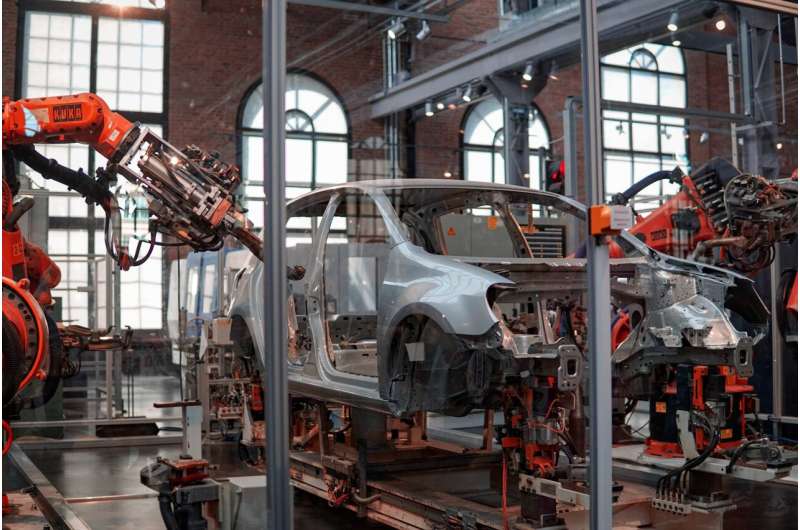A 'red alert' for workers: Businesses embrace automation during the COVID-19 pandemic

Now is a good time for U.S. workers. They are operating from a position of strength as an ongoing labor shortage creates greater demand and incentivizes higher wages for their services.
But those gains are temporary, warns Nada Sanders, distinguished professor of supply chain management at Northeastern.
The unmet demand and rising costs for skilled labor are convincing employers to automate their businesses at an accelerated rate—which will result in fewer job opportunities for many of the workers who appear to be doing so well today.
"There is critical demand for workers across every sector—from hospitality to restaurants to nursing to truck drivers, you name it," says Sanders. "But that leverage is going to rapidly shrink and go away.
"This is a red alert for workers who need to understand that many of their jobs are going to be pushed out by technology," Sanders says. "And once they go, they're not coming back."
The momentary labor shortage is driven in part by "The Great Resignation" that has been spurred by the millions of American workers who have quit jobs during the COVID-19 pandemic. Supply-chain shortages and other business interruptions related to the pandemic are also contributing to the dramatic shift toward automation by U.S. companies, says Sanders.
"In autumn 2019, before COVID hit, I was talking to companies about their hesitation to go digital because of the amount of money it would cost," Sanders says. "But we are in a different era now. We're two years into this pandemic, and these companies are smart. They're saying they're not going to be caught with their pants down again. Of the companies I've talked to, they're all investing a significant increase—5% to 10% of revenues—in automation."
A World Economic Forum survey of close to 300 companies around the world last year found that 43% envisioned cutting back on workers in favor of new technology.
"The prices used to be astronomical, but the technology is now more commonplace and it's actually affordable for small businesses," Sanders says of the drive to automation. "Businesses are aware that if they make this investment, they're not having to pay for benefits, Social Security, healthcare, and [in terms of automated systems] they're not worrying about COVID and the variants that are coming."
The development shows some obvious signs, says Tucker Marion, a Northeastern associate professor of technological entrepreneurship, who notes how national retailers, including CVS, and restaurants such as McDonald's, have been replacing cashiers with self-service kiosks. That's just the beginning.
"You have those jobs that can be replaced by automation, which is reliable and doesn't require a lot of technicians to maintain it," Marion says. "You'll see that in grocery stores, warehouses, restaurants. Workers need to think about what skills they're going to develop for the workplace."
Employers want workers who can provide specific skills that weren't in demand a few years ago. That's why Amazon is offering free tuition to employees, says Sanders, in addition to educational programs for employees on data center maintenance and technology, IT, and user experience and research design.
It's also why the Roux Institute at Northeastern was launched in 2019: To train high-tech workers capable of sparking a digital renaissance in Maine, a state that was struggling to train workers who could grow and maintain cutting-edge industries.
"When job offers are made, it is reasonable to ask, "Is it possible to get reskilling, training, tuition, or something along those lines as part of the compensation package?'" says Sanders. "If I were a worker, in my job negotiation, I would want a chance to reskill and upskill so that I am ready for this new age that is absolutely coming, and it's coming very fast."
Sanders notes that a variety of innovations are already changing the U.S. workplace, including:
- Spot, an agile four-legged robot sold by Boston Dynamics, which can perform dangerous surveying tasks at construction sites.
- Dark stores, or micro-fulfillment centers, that provide deliveries to nearby customers. Soon, envisions Sanders, these stores will be operated by robots.
- Amazon Go stores, in which cameras and intelligent software track customer purchases and charge them as they leave the premises—which makes the cashier kiosk redundant.
Sanders and Marion recall the message of "Robot-Proof: Higher Education in the Age of Artificial Intelligence," in which Northeastern President Joseph E. Aoun proposed ways to educate future generations to thrive in the automated economy. People should invest in areas of perception and creativity—strengths that machines can't yet match, notes Marion.
What are the jobs of the future? "It is a challenging question," Marion says. "For the foreseeable future, there will be a need for highly technical backgrounds and skills—materials science, computer science, engineering, analytics, physics, medicine, biomedical—where we are combining different fields together. Interdisciplinary technical skills will be extremely valuable because technology is going to change, and being able to have combinations of skills in different technical fields is very important."
The embrace of automated systems by businesses is a movement that transcends the current supply chain shortages, says Sanders.
"I really see this as a community service—we've got to get the word out to workers," says Sanders. "What you don't want is to be caught in a situation where, in a year or two, this job is no longer there, and you no longer have the leverage, and you do not have the skill-set to compete in the new job market."
Provided by Northeastern University





















